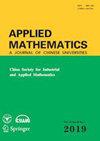改良的右螺旋体可以模拟哺乳动物听觉器官中耳蜗的内部结构
IF 1
4区 数学
Applied Mathematics-A Journal of Chinese Universities Series B
Pub Date : 2021-05-18
DOI:10.4236/AM.2021.125028
引用次数: 2
摘要
本研究的目的是建立在哺乳动物听觉系统中起重要作用的耳蜗中心螺旋基底膜的数学模型。基底膜传递声音振动,声音振动通过内部毛细胞转化为电位变化。基底膜被认为位于一个局部未扭曲的曲面上,因为在基底膜上有序排列的内层毛细胞对它们的位置特异性频率做出反应。在哺乳动物中,这个表面的旋转次数和每次旋转的宽度变化率是不同的。结果表明,通过对螺旋面进行修正,可以得到满足这些点的数学模型。综上所述,尽管基底膜的三维结构因物种而异,但该模型可以再现这种结构。这进一步表明,哺乳动物的耳蜗发育有共同的遗传决定因素。从实用的角度来看,这可能有助于制造人工耳蜗。本文章由计算机程序翻译,如有差异,请以英文原文为准。
A Modified Right Helicoid Can Simulate the Inner Structure of the Cochlea in the Hearing Organ of Mammals
The purpose of this study is to develop a mathematical model of the spiral basilar membrane in the center of the cochlea, which plays an important role in the mammalian auditory system. The basilar membrane transmits sound vibrations, which are converted into electrical potential changes by the inner hair cells. The basilar membrane is thought to lie on a locally undistorted curved surface because the inner hair cells, which are arranged in an orderly fashion on the basilar membrane, respond to their location-specific frequencies. In mammals, the number of rotations of this surface and the rate of change of its width with each rotation are different. It turns out that by modifying the right helicoid, we can obtain a mathematical model that satisfies these points. In conclusion, even though the three-dimensional structure of the basilar membrane varies among species, this model can reproduce this structure. This further suggests that there are common genetic determinants of cochlear development in mammals. From a practical standpoint, this may be useful for creating cochlear implants.
求助全文
通过发布文献求助,成功后即可免费获取论文全文。
去求助
来源期刊

Applied Mathematics-A Journal of Chinese Universities Series B
MATHEMATICS, APPLIED-
自引率
10.00%
发文量
33
期刊介绍:
Applied Mathematics promotes the integration of mathematics with other scientific disciplines, expanding its fields of study and promoting the development of relevant interdisciplinary subjects.
The journal mainly publishes original research papers that apply mathematical concepts, theories and methods to other subjects such as physics, chemistry, biology, information science, energy, environmental science, economics, and finance. In addition, it also reports the latest developments and trends in which mathematics interacts with other disciplines. Readers include professors and students, professionals in applied mathematics, and engineers at research institutes and in industry.
Applied Mathematics - A Journal of Chinese Universities has been an English-language quarterly since 1993. The English edition, abbreviated as Series B, has different contents than this Chinese edition, Series A.
 求助内容:
求助内容: 应助结果提醒方式:
应助结果提醒方式:


